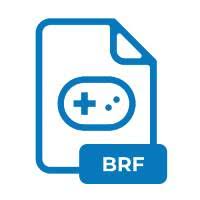.BRF File Extension

Braille Ready Format File
| Developer | N/A |
| Popularity | |
| Category | Data Files |
| Format | .BRF |
| Cross Platform | Update Soon |
What is an BRF file?
.BRF (Braille Ready Format) is a file format specifically designed for representing electronic Braille documents. It is used to store and display Braille text, allowing visually impaired individuals to access and read digital content using Braille displays or Braille embossers. This format enables the conversion of electronic text into a format that can be easily interpreted by Braille reading devices.
More Information.
.BRF files were first introduced to address the limitations of traditional Braille documents, which were often produced manually or through cumbersome processes. The creation of .BRF files marked a significant advancement in the accessibility of digital content for the visually impaired. These files were designed to streamline the conversion of electronic text into Braille and facilitate the distribution of Braille materials in digital formats.
Origin Of This File.
The .BRF file format was developed to provide an efficient and standardized way to distribute electronic Braille documents. It emerged as a response to the growing need for accessible digital content for the visually impaired community. The development of .BRF files aimed to enhance accessibility and improve the reading experience for individuals who rely on Braille for literacy.
File Structure Technical Specification.
.BRF files typically contain encoded Braille characters represented in a structured format. Each character is mapped to its corresponding Braille symbol, allowing Braille reading devices to interpret the text accurately. The technical specifications of .BRF files may vary slightly depending on the software or platform used to create them, but they generally adhere to standard encoding conventions for Braille representation.
How to Convert the File?
Windows:
- Install a Braille translation software such as Duxbury Braille Translator or BrailleBlaster on your Windows computer.
- Open the software and import the file you want to convert into .BRF format.
- Follow the software’s instructions to select the appropriate translation options and settings.
- Once configured, initiate the conversion process, and the software will generate the .BRF file for you.
Linux:
- Install Braille translation tools such as BrailleBlaster or Liblouis on your Linux system.
- Open the tool of your choice and import the file you wish to convert.
- Configure the translation settings as needed, ensuring compatibility with your target Braille device.
- Start the conversion process, and the tool will produce the .BRF file for you to use.
Mac:
- Install Braille translation software like Duxbury Braille Translator or BrailleBlaster on your Mac device.
- Launch the software and import the file you want to convert into .BRF format.
- Adjust the translation settings according to your preferences and the requirements of your Braille display or embosser.
- Initiate the conversion process, and the software will generate the .BRF file for you to access and use.
Android:
- Install a Braille translation app such as BrailleBack or BrailleBlaster on your Android device from the Google Play Store.
- Open the app and import the file you wish to convert into .BRF format.
- Configure the conversion settings as necessary, ensuring compatibility with your Braille display.
- Start the conversion process, and the app will generate the .BRF file for you to use on your device.
iOS:
- Install a Braille translation app such as Voice Dream Reader or BrailleBlaster on your iOS device from the App Store.
- Launch the app and import the file you want to convert into .BRF format.
- Adjust the conversion settings based on your preferences and the specifications of your Braille display.
- Initiate the conversion process, and the app will create the .BRF file for you to access and utilize on your iOS device.
Advantages And Disadvantages.
Advantages:
- Enhanced Accessibility: .BRF files enable visually impaired individuals to access digital content through Braille displays or embossers.
- Standardization: The .BRF format provides a standardized way to distribute Braille documents, ensuring compatibility across different devices and software platforms.
- Improved Efficiency: .BRF files streamline the conversion process of electronic text into Braille, making it easier to produce and distribute Braille materials.
Disadvantages:
- Limited Formatting: .BRF files typically lack advanced formatting options, which may limit the presentation of complex documents.
- Dependency on Braille Devices: .BRF files can only be accessed and interpreted using compatible Braille reading devices or software, which may restrict accessibility for some users.
- Conversion Challenges: Converting text into .BRF format may require specialized software or tools, which could pose challenges for individuals or organizations unfamiliar with the process.
How to Open BRF?
Open In Windows
Use software like Duxbury Braille Translator or BrailleBlaster, which support .BRF file creation.
Open In Linux
Utilize tools such as BrailleBlaster or Liblouis, which offer support for .BRF file conversion.
Open In MAC
Software like Duxbury Braille Translator or BrailleBlaster can be used on Mac systems to convert files into .BRF format.
Open In Android
Android apps such as BrailleBack or BrailleBlaster may support .BRF file conversion.
Open In IOS
iOS apps like Voice Dream Reader or BrailleBlaster may offer .BRF file conversion capabilities.
Open in Others
Other platforms may also support .BRF file conversion through specialized software or tools designed for Braille document creation and accessibility.













